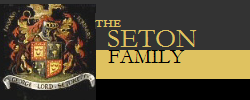|
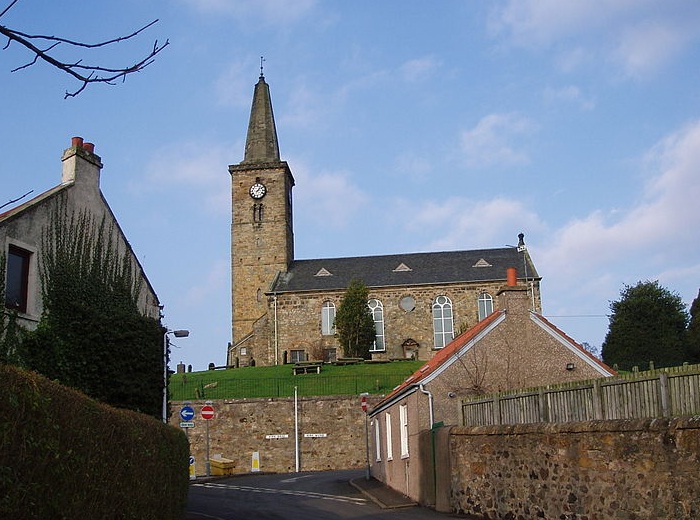 “The memory of great men is no less useful
than their presence.”
George, 4th Earl of Winton. “The memory of great men is no less useful
than their presence.”
George, 4th Earl of Winton.
The Seton's of Cariston, and Burial at St.
Drostan's in Markinch, and St. Kenneth's, Kennoway, and later of St. Kea,
Treskerby in Cornwall
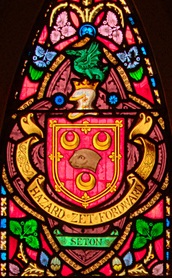 The
parish church of Markinch, prominently situated on a mound
at the highest point of the town, and dedicated to the
Pictish St. Drostan, is recorded in documents from the 11th
century on, though it may well be of earlier origin. Though
the body of the church is a plain Georgian 'preaching box'
of 1786, the adjoining tower is medieval, and dates to the
late 11th-early 12th centuries. The
parish church of Markinch, prominently situated on a mound
at the highest point of the town, and dedicated to the
Pictish St. Drostan, is recorded in documents from the 11th
century on, though it may well be of earlier origin. Though
the body of the church is a plain Georgian 'preaching box'
of 1786, the adjoining tower is medieval, and dates to the
late 11th-early 12th centuries.
Of exceptionally
fine masonry, it is very similar to the tower of St. Rule's
Church in St Andrews, and may be a copy of it on a smaller
scale. It is crowned by a rather incongruous small Classical
spire, which was added in 1807. There are Seton
burials located between here and at the nearby St. Kenneth's
in Kennoway.
In Kennoway, The Causeway or the Old Parish Church and
Churchyard with Session and Watch House, has an age which
from its structure, must be very great. The lintel of a door
which is supposed to be of the same date as an addition made
to the original edifice, has 1619 inscribed on it.
The old church of Kennoway was given by Merleswain, son of
Colbain, to the Priory of St Andrews about the middle of the
12th century. The church was dedicated to St Cainnichi or St
Kenneth. Later, it became one of the traditional burial
grounds of the Seton's of Cariston, who were also
Baron-Baillie's of Kennoway.
The earliest
known "church" in Kennoway was thought to date back to St.
Kenneth, who first preached the Christian faith in the East
of Fife in the 6th. century AD. Records also account for a
church in Kennoway under the cannery of St. Andrews in 1177.
There are no
remains of the original church, and the present parish
church of Kennoway was erected in 1850. A survey of the
graveyard monuments of Kennoway Churchyard was carried out
in June 1998.
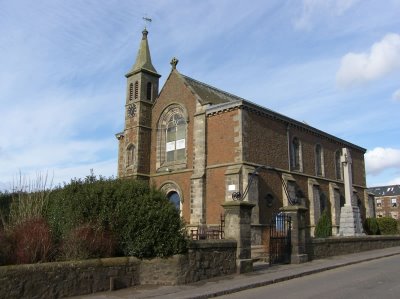 The
Seton House appears in local history as the dower house of
Blackhall Castle (also a Seton family residence) and as the
town house of Captain Robert Seton of Drummaird. However,
the Seton coat of arms reported to be sited over the main
entrance is not evident on this building. There is however a
fine coat of arms set above a garage door a few yards N of
this site. On the afternoon of 2nd May 1679, the Archbishop
Sharp crossed the Forth, and lodged that night in Captain
Seton's house, still standing in the village of Kennoway,
before his murder on Magus Muir. The
Seton House appears in local history as the dower house of
Blackhall Castle (also a Seton family residence) and as the
town house of Captain Robert Seton of Drummaird. However,
the Seton coat of arms reported to be sited over the main
entrance is not evident on this building. There is however a
fine coat of arms set above a garage door a few yards N of
this site. On the afternoon of 2nd May 1679, the Archbishop
Sharp crossed the Forth, and lodged that night in Captain
Seton's house, still standing in the village of Kennoway,
before his murder on Magus Muir.
The date of the
earliest entry in the parochial register, is supposed to be
in 1634, and an entry, bearing the date 1635, is also
perfectly distinct. After this, on a subsequent page, comes
July 1638 ; and though the book in which these dates are
found, is not in a state of very good preservation, yet the
details of the transactions of the kirk-session, given with
great minuteness, and often showing an extreme degree of
vigilance and rigour in the exercise of authority, may be
gathered from the last-mentioned date, with few, if any
exceptions, continuously down to December 1675.
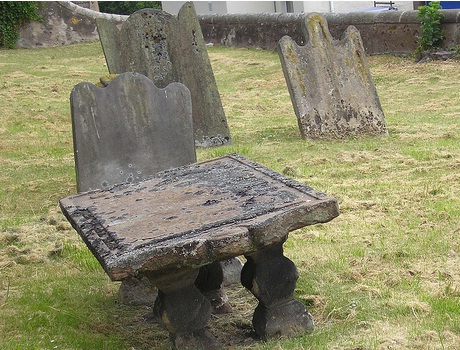 From
this time, however, to 1690, a period of about fifteen
years, there is an entire blank ; and the same thing occurs
between 1755 and 1761. From this last date, up to the
present time, the records are entire. What could have
occasioned the blanks above referred to, it is impossible to
say determinately: but the probability is, that the minutes
had been originally kept, and that the books which contained
them have been lost: for the volumes preserved are filled
with minutes of transactions in regular succession, and the
blanks occur in both cases between the conclusion of one
volume and the commencement of another. From
this time, however, to 1690, a period of about fifteen
years, there is an entire blank ; and the same thing occurs
between 1755 and 1761. From this last date, up to the
present time, the records are entire. What could have
occasioned the blanks above referred to, it is impossible to
say determinately: but the probability is, that the minutes
had been originally kept, and that the books which contained
them have been lost: for the volumes preserved are filled
with minutes of transactions in regular succession, and the
blanks occur in both cases between the conclusion of one
volume and the commencement of another.
The situation of
the parish church in the village of Kennoway, renders it
convenient for by far the greater part of the population;
there being in that village, and within the compass of about
half a mile around it, upwards of 1100 inhabitants. The
distance of the church from the most remote extremities of
the parish is between two and three miles. The age of the
church must, from its structure, and the height to which the
surrounding burying-ground has accumulated above its
foundation, be very great; but there are no means of
ascertaining the exact period at which it was built. The
lintel of a door, which is supposed to be of the same date
with an addition that had been made to the original edifice,
has 1619 inscribed on it.
The present
state of repair of the church, however, notwithstanding its
great age, is exceedingly good. Perhaps it is to be
regretted, considering its size, as compared with the
Population, that it is so good ; and that such a sum as
nearly L. 200 was expended in putting it into its present
comfortable state, so lately as in the summer of 1832.
The number of
sittings in it was at one time 463, while the number of
families belonging to the Establishment in the parish is
238, and that of individuals of all ages 1027, exceeding the
number of sittings in the church. | 